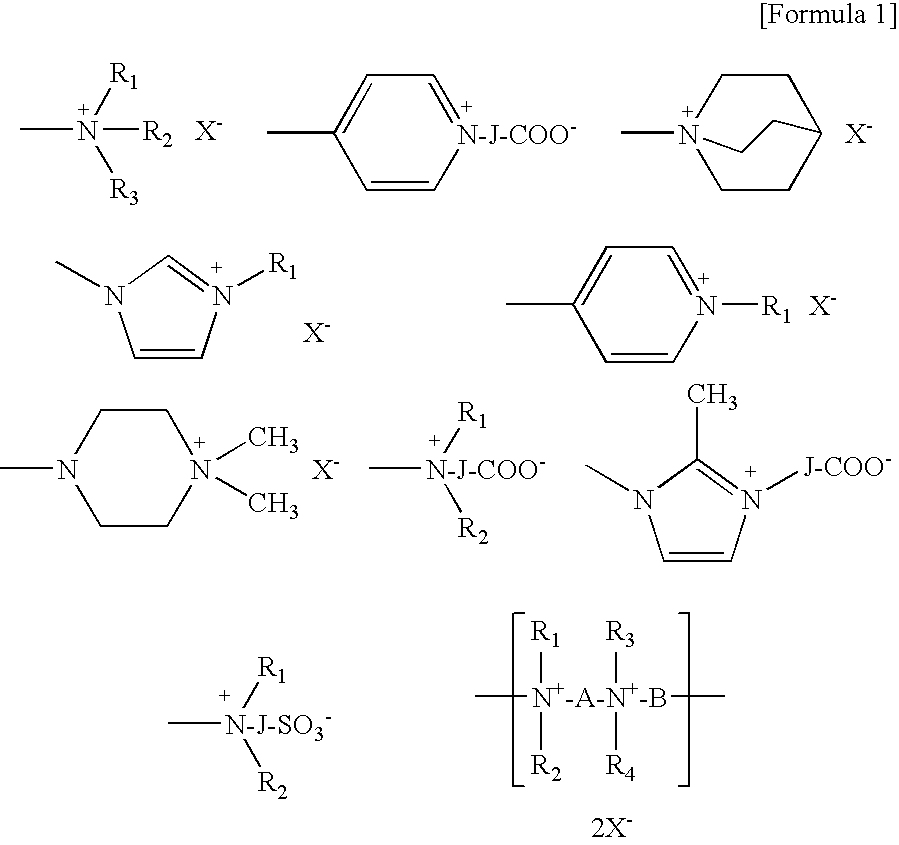Antistatic Anti-glare film
a film and anti-glare technology, applied in the field of anti-glare film, can solve the problems of high manufacturing cost, coloration of the film, visual glare of the display surface, etc., and achieve the effect of reducing cost and high efficiency
- Summary
- Abstract
- Description
- Claims
- Application Information
AI Technical Summary
Benefits of technology
Problems solved by technology
Method used
Image
Examples
example 1
(1) Preparation of Antiglare Layer-Forming Composition
[0181]An antiglare layer-forming composition was prepared by mixing the following components: 100 parts of an ionizing radiation-curable resin (pentaerythritol triacrylate); 6.0 parts of a photopolymerization initiator (Irgacure 184 (trade name) manufactured by Ciba Specialty Chemicals Inc.); 1.25 parts of a thermoplastic resin (cellulose propionate); 7.5 parts of optically-transparent fine particles (melamine beads); 5 parts of a polymeric cationic antistatic agent (a quaternary ammonium salt-containing acrylic resin PQ-10 (trade name) manufactured by Soken Chemical & Engineering Co., Ltd.); 0.04 parts of a fluoride additive (FZ2191 (trade name) manufactured by Nippon Unicar Company Limited); and 140.3 parts of a solvent (toluene)
(2) Preparation of Antistatic Antiglare Film
[0182]The antiglare layer-forming composition prepared in the section (1) was applied to an 80 μm thick triacetylcellulose (TAC) film by gravure reverse coati...
example 2
(1) Preparation of Antiglare Layer-Forming Composition
[0189]An antiglare layer-forming composition was prepared by mixing the following components: 277 parts of a polymeric cationic antistatic agent-containing binder (ASC-EX9000 (trade name) manufactured by Kyoeisha Chemical Co., Ltd., containing a quaternary ammonium salt-containing polymer, an ionizing radiation-curable resin and a photopolymerization initiator); 1.25 parts of a thermoplastic resin (cellulose propionate); 7.5 parts of optically-transparent fine particles (melamine beads); 0.04 parts of a fluoride additive (FZ2191 (trade name) manufactured by Nippon Unicar Company Limited); and 25 parts of a solvent (toluene).
(2) Preparation of Antistatic Antiglare Film
[0190]An antistatic antiglare film was prepared using the process of Example 1, except that the antiglare layer-forming composition prepared in the section (1) was used instead. The antistatic antiglare film was measured for the surface resistivity and the minimum re...
example 3
[0205]An antistatic antiglare film having an antiglare layer with a multilayer structure of an irregular undercoat layer and a surface profile control layer was prepared.
[0206](1) Preparation of Antiglare Layer-Forming Compositions
[0207]
[0208]A composition with a solids content of 40.5% was prepared by thoroughly mixing the components below. The composition was filtered through a polypropylene filter with a pore size of 30 μm to give an irregular undercoat layer-forming composition 1. The components: ionizing radiation-curable resins: 2.18 parts by weight of pentaerythritol triacrylate (PETA) (1.51 in refractive index), 0.98 parts by weight of dipentaerythritol hexaacrylate (DPHA) (1.51 in refractive index) and 0.31 parts by weight of poly(methyl methacrylate) (75,000 in molecular weight); 0.20 parts of a photopolymerization initiator (Irgacure 184 (trade name) manufactured by Ciba Specialty Chemicals Inc.); 0.03 parts of another photo...
PUM
| Property | Measurement | Unit |
|---|---|---|
| surface resistivity | aaaaa | aaaaa |
| humidity | aaaaa | aaaaa |
| temperature | aaaaa | aaaaa |
Abstract
Description
Claims
Application Information
 Login to View More
Login to View More - R&D
- Intellectual Property
- Life Sciences
- Materials
- Tech Scout
- Unparalleled Data Quality
- Higher Quality Content
- 60% Fewer Hallucinations
Browse by: Latest US Patents, China's latest patents, Technical Efficacy Thesaurus, Application Domain, Technology Topic, Popular Technical Reports.
© 2025 PatSnap. All rights reserved.Legal|Privacy policy|Modern Slavery Act Transparency Statement|Sitemap|About US| Contact US: help@patsnap.com



